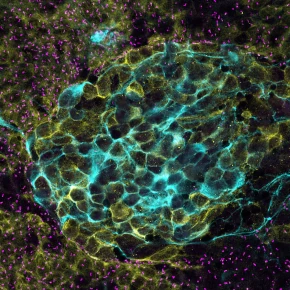Team Philippe MARIN
Neuroproteomics and signalling of brain disorders
Project GPCR signaling, compartmentalization and pathophysiological roles
PRINCIPAL INVESTIGATOR

IGF staff involved
Philippe MARIN
DRCE CNRS
Tristan BOUSCHET
CRCN CNRS
Sonya GALANT
IECN CNRS
Serge URBACH
IRCN CNRS
Clémence QUITTET
Doctorante UM
Ophélie BENTO
IE CDD CNRS

G protein-coupled receptors (GPCRs) are the target of over 30% of the drugs on the market. These membrane proteins interact with complex protein networks, playing key roles in their physiological functions. These partners can change depending on the stage of development or on the receptor’s subcellular location. In order to better define the physio-pathological roles of GPCRs, we aim to identify their partners during development and in different subcellular compartments using state-of-the-art proteomic approaches in stem cells.
The serotonin 5-HT6 receptor plays a key role in neuronal development and is a promising target for the treatment of cognitive deficits associated with neurodevelopmental disorders. In humans, the 5-HT6 receptor has been implicated in the pathogenesis of neurological and psychiatric disorders, including dementia, psychosis and autism spectrum disorders (ASD). In mice, genetic inactivation of the receptor induces behavioral deficits similar to those observed in models of ASD. The molecular mechanisms underlying the control of neuronal development and cognition by the 5-HT6 receptor remain poorly characterized. In addition to its canonical coupling to the Gs protein, the 5-HT6 receptor engages the mTOR pathway, which underlies the cognitive deficits observed in mouse models of schizophrenia. However, there is also evidence that the receptor may engage other signaling pathways, depending on its developmental stage and subcellular localization.
Indeed, its subcellular localization is dynamic and varies during development. During the first ten days after birth, it is predominantly expressed at the membrane of cell bodies. In adults, however, it is mainly found in the primary cilia of neurons and astrocytes, especially at axo-ciliary synapses, where it controls histone expression, epigenetic modifications and chromatin structure. Using state-of-the-art omics approaches in embryonic stem cell models that we are developing, this research project aims to address 3 issues
- Identification of receptor partners in different cellular compartments during development
- Identify signaling pathways associated with the receptor in different cellular compartments during development.
- Identify epigenetic modifications involved in the regulation of gene expression by the ciliary 5-HT6 receptor in a physiological or pathological context.

The ciliary 5-HT6 receptor (cyan) expressed in embryonic stem cells is concentrated around regions rich in the serotonin transporter SERT (magenta).
Main publications
• Dupuy V., et al. (2023) Neurobiol Dis 176, 105949.
• Chaumont-Dubel S., et al. (2023), Cells 12, 426.
• Sheu SH., et al, (2022) Cell 185, 3390-407 e18
• Chaumont-Dubel S., et al. (2020), Neuropharmacology 172, 107839
• Deraredj Nadim W., et al. (2016), PNAS 113, 12310-15
• Duhr F., et al. (2014), Nature Chemical Biology10, 590-7
• Jacobshagen M., et al. (2014), development 141, 3370-7
• Meffre J., et al. (2012), EMBO molecular medicine 4, 1043-56
Funding
• 2022-2025 ANR ContAct – Participant
• 2020-2023 Project MUSE ecoSero6TSA – Coordinator for Biology
• 2018-2022 ANRJCJC- Sero6Dev – Coordinator
• 2011-2015 ANR 2020-SERO6COGNET – Participant
Collaborations
• Julie Le Merrer et Jérôme Becker (Tours)
• Shu-Hsien Sheu (San Francisco Bay Area)
• François Tronche (Paris)
• Frédéric Lamaty et Xavier Bantreil (Montpellier)
• Pawel Zajdel (Cracovie)
• Evgeni Ponimaskin (Hannovre)
Alumni
• Fanny Duhr (Thesis)
• Camille Pujol (Thesis)
• Vincent Dupuy (Thesis)
• Ophélie Bento (Thesis)
• Amos Fumagalli (Thesis)
• Léonie Runtz (Master 2)
• Matthieu Prieur (Master 2)
• Clara Margarido (Engineer UM)
Patents
• Zajdel P., Drop M, Canale V., Pawlowski M., Satala G., Bojarski A., Subra G., Martinez J., Bantreil X., Lamaty F., Martin P-Y., Courteix C, Chaumont-Dubel S., Marin P. WO2020117075A1, 2020


